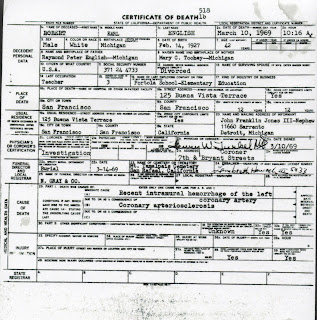I bought a painting at auction last year. I didn't know a thing about the artist, but I was drawn to the bright saturated colors and abstracted cityscape composition and I knew from looking at the back of the canvas that it had some age to it. There were two other paintings by the same artist in the auction that day, but my shallow pockets left me with only one prize.
Luckily, I was able to take photographs of the other canvases, both front and back, to help with my research. My new abstract was signed "R. English" and inscribed on the back "Hodge's Lodge." Another painting was inscribed with the artist's address, 125 Buena Vista Terrace, San Francisco. That's all I had to go on. Here's what my sleuthing uncovered:
A copy of Robert “Bob” English's death certificate. He was born on February 14, 1927 in Wayne, Michigan, 25 miles west of Detroit. From census reports, I gleaned that his father was a retail store salesman and Robert was the youngest of 3 children. At 18, he enlisted in the Army and served from 1945-46, at the end of World War II.
In 1957, he moved to San Francisco, and for the next 12 years maintained a residence at 125 Buena Vista Terrace, a short walk to Haight-Ashbury, which was in its bohemian heyday in the 1960s. English was a well-respected teacher at Portola Elementary School in San Bruno, from 1965, until his untimely death at the age of 42 on March 10, 1969. The school held an art show in his honor for several years after his death.
 |
| Portola Elementary School photo |
Although it is not known where English studied art, living in San Francisco in the 1960s, he was certainly exposed to the work of the San Francisco Abstract Expressionists, who had been active in the city since the 1940s, as well as the Bay Area Figurative artists who broke away from non-objective painting in the 1950s. It was a radical time in San Francisco's history with counterculture Beatnik poets, writers and free thinkers mixing with the peace-loving Hippie generation. The area's breathtaking landscape and the revival of jazz were also essential influences on San Francisco artists.
"Hodge’s Lodge" (painting seen at top of post) references the cool sounds of
Johnny Hodges and his jazz orchestra, Hodge Podge. Hodges was a premier alto saxophonist who also played first chair in Duke Ellington's band for many years.
 |
| Harlem Air Shaft |
 |
| It Don't Mean a Thing If It Ain't Got That Swing |
The two Robert English paintings that got away are titled "Harlem Air Shaft" and "It Don’t Mean a Thing If It Ain’t Got That Swing", after compositions of the same name by Duke Ellington and his jazz orchestra. In arrangement, the canvases reflect the chaotic, expressive street rhythm of Harlem that resonates through Ellington's music.






